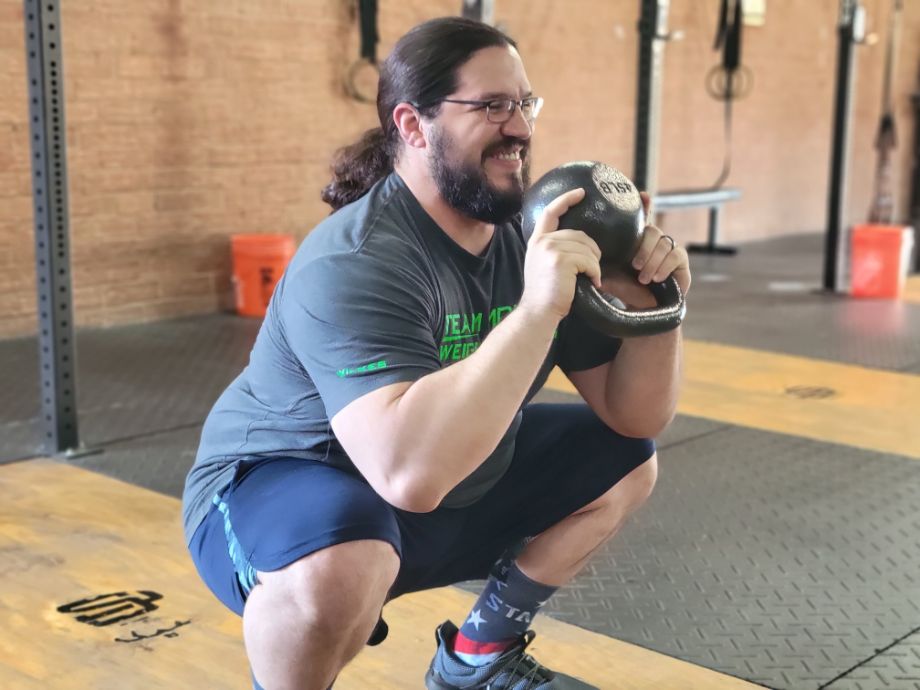We test and review fitness products based on an independent, multi-point methodology. If you use our links to purchase something, we may earn a commission. Read our disclosures.
Most lower-body workouts include exercises we all know about, such as barbell squats, walking lunges, Romanian deadlifts (RDL), Bulgarian split squats, and more.
But what about lesser-known exercises that specifically activate the adductors?
Targeted adductor exercises aren’t usually the first on the list of lower-body workouts. Sometimes, there are none at all. Although this is often true, there are multiple benefits to training the adductors, including improved flexibility, better compound lifts, and reduced risk of injury.
We’ll start by explaining what the adductors are, our top tips for training the adductors, and then, step-by-step, explain how to perform the eight best adductor exercises. By the end of this article, we’re confident you’ll add at least a couple these movements to your workout program.
Medical disclaimer: This article is intended for educational and informational purposes only. It is not a substitute for health or medical advice. For medical advice, contact an appropriate healthcare provider.
What Are the Adductors, And What Do They Do?
Five muscles form the adductors. These are the adductor longus, adductor magnus, adductor brevis, pectineus, and gracilis. Usually, they originate from the pelvis and insert into the femur1. The gracilis muscle, however, passes the knee joint and inserts onto the proximal medial tibia.
The adductor magnus is the largest and most powerful of the five muscles. It’s large and triangular, and is responsible for extending the hip and adducting the femur2. The adductor magnus also helps to perform many movements, including walking, squatting, balancing, and kicking during sports such as soccer.
Collectively, the main role of the adductor muscles is to move the hips and thighs toward the middle of the body (adduction). They’re also responsible for stabilizing the pelvis, hip flexion, hip extension, and hip rotation, and knee flexion1.
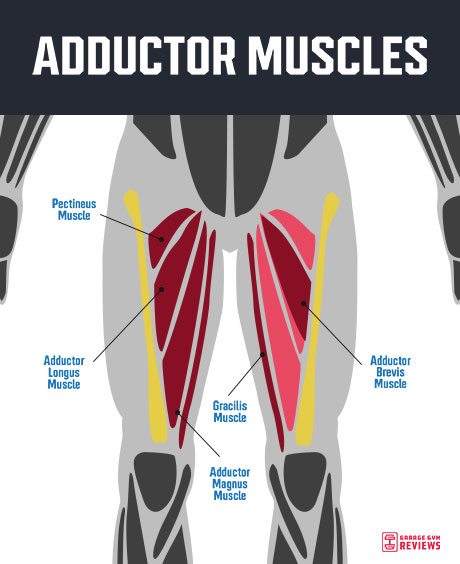
Tips for Training the Adductors
Before we get into the best adductor exercises, here are some tips for training them. We consulted with Dr. Michael Masi, a doctor of physical therapy (DPT), personal trainer, and owner of Masi Fitness, to explain how to make the most out of your adductor training.
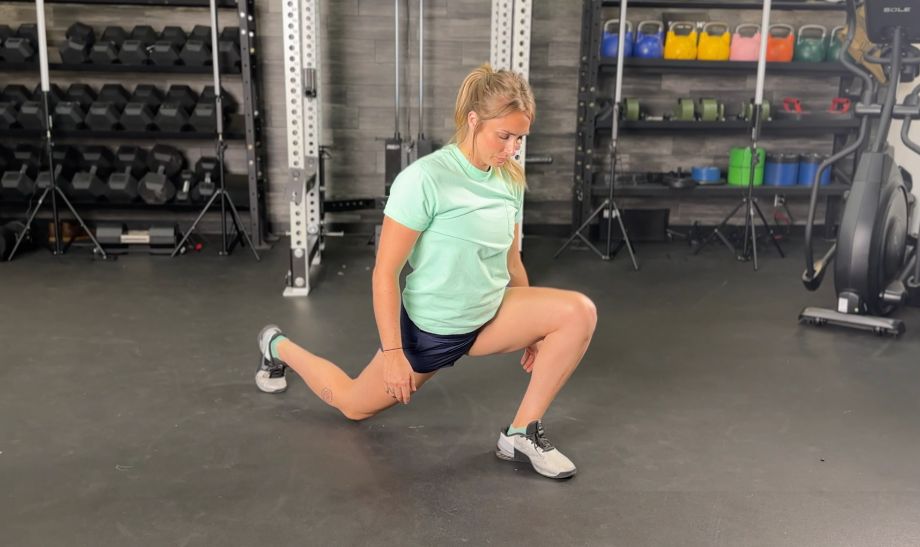
Warm Up First
As with most workouts, it’s important to warm up and stretch before doing adductor exercises. Spend five to 10 minutes on the treadmill or cross trainer, and then do some stretches. Great stretches for the groin muscles include leg swings, butterfly stretch, frog stretch, and more. Foam rollers are another tool you can use to help with increased tightness.
Contract The Muscles
It’s important to feel and contract the adductor muscles when doing any adductor exercise. “Take each rep slowly, especially between the eccentric and isometric phase when the muscle is lengthened to return to its original position,” explains Dr. Masi. The mind-muscle connection3 can make a significant difference when it comes to resistance training.
Gradually Increase Range Of Motion And Resistance
We’d recommend two things for those new to adductor training (or new to resistance training altogether). First, use less weight. Second, don’t push the range of motion to the point where it feels unsafe or uncomfortable. Slow and steady wins this race. Always. You can increase your weight and intensity once you get more familiar with the exercises.
RELATED: What is Resistance Training
Adductors Vs Abductors
You might be thinking, “What’s the difference between adductors and abductors? Aren’t they the same thing?” No, they’re not. Both sets of muscles pass the hip joint; however, adductors and abductors have opposite actions.
Abductors move your legs away from your body’s midline4, whereas adductors move your legs toward it. The abductors sit on the outside of the hips, and yes, you guessed it, the adductors are located on the inside of your thighs.
When you kick your leg out to the side and bring it back to the center, you use both your abductors and adductors. Both of these muscle groups are of particular importance when your foot is in contact with the floor because they will help control where your knee is in space and even influence internal and external rotation of the hip as the knee bends.
The Best Adductor Exercises to Work Into Your Routine
Now you know the difference between adductors and abductors, as well as our top tips for training the adductors, here are our eight favorite adductor exercises for you to try:
Lateral Lunges
Why it’s great: Lateral lunges (aka side lunges) are an excellent exercise for the adductors, abductors, hamstrings, quads, and glutes. “Because you’re going from side to side, you contract the adductors every time you lean in, helping you to improve your hip flexibility while doing so,” says Dr. Masi.
How to do it:
- Begin by standing up with your feet positioned hip-width apart. You can do this exercise with your body weight only or holding the best dumbbells in each hand.
- Step to the left as far as possible, and bend your left knee as you do so. Push your hips backward at the same time.
- Hold for a moment, then drive your left foot into the floor to return to the starting position.
- Repeat, but this time, step out to the right instead.
- Keep going for repetitions, alternating between the left and right sides.
RELATED: Your Guide to Lunge Exercises
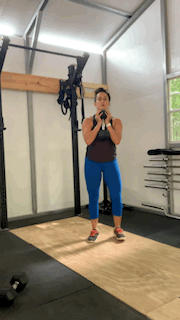
Seated Banded Adduction
Why it’s great: The seated banded adduction is similar to the standing version (which you’ll see below), but is easier to do because you’re sitting rather than standing. Both feet stay on the ground, which means you’re stable at all times. This makes it a great exercise for beginners.
How to do it:
- Loop a resistance band around a power rack or another large, immovable object.
- Sit down on a bench or a chair, near the resistance band.
- Loop the other end of the resistance band around your left knee.
- Move your left knee toward the anchor point, by opening up both legs. Keep both feet planted on the ground throughout.
- Pause, then slowly bring both knees to the midline of your body.
- Complete all repetitions, then repeat on your right side.
RELATED: Best Resistance Bands
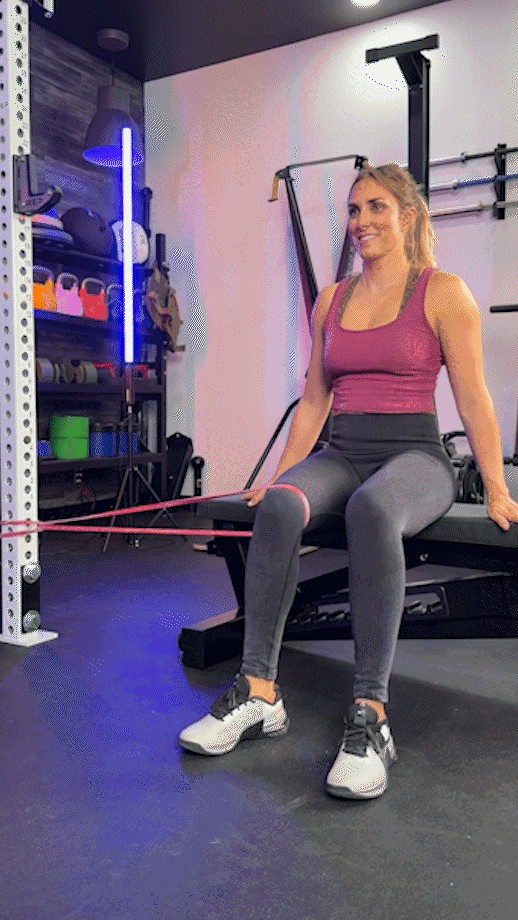
Wide Stance Squat
Why it’s great: A wide stance squat, or sumo squat, differs from a regular squat because of the inner thigh activation when your stance is wider. “This [exercise] could help to develop width in your leg muscles and may help improve your form and increase your weights on regular squats, too,” Dr. Masi explains.
How to do it:
- Stand with your feet wider than shoulder-width apart and your toes pointing outward at a 45-degree angle.
- Engage your core, keep your back straight, and then lower your body towards the ground by bending at the hips and knees.
- Make sure the knees track outward, away from each other, in the 45-degree angle that the toes are set at.
- Lower until your thighs are parallel to the floor (or even further), making sure to keep your chest up at all times.
- Pause, then push through your heels to return to the original position. If this is too easy, add some resistance (for example, hold a dumbbell or kettlebell).
- Repeat for the desired number of reps.
RELATED: Kettlebell Squats
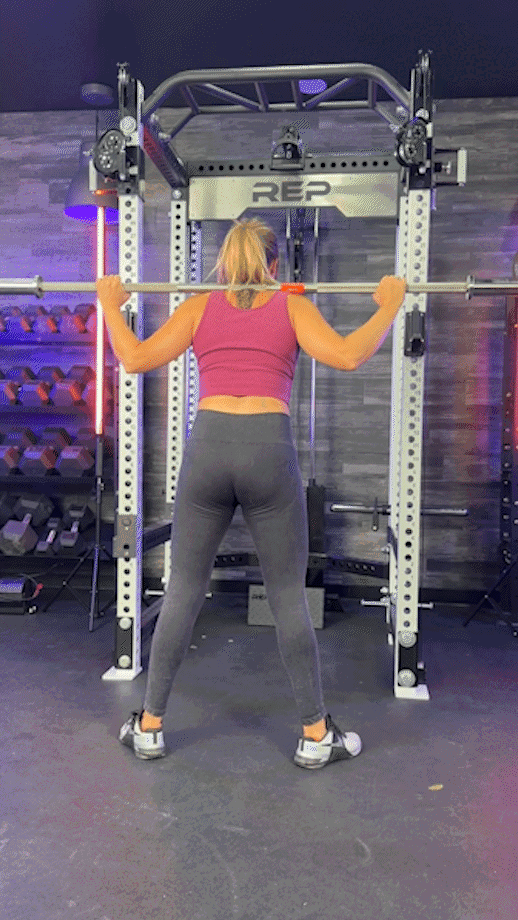
Single-Leg Glute Bridge
Why it’s great: Because you’re doing one leg at a time, single-leg glute bridges can help to fix muscular imbalances on either side of your body. It’s a great functional exercise and may help to increase your lower back strength too. Add a dumbbell or barbell if it gets too easy.
How to do it:
- Using the best exercise mat, lie down with your back on the floor, facing the ceiling.
- Bend your knees so your feet are flat on the floor, and put your arms down by your side.
- Lift your left foot off the floor, straightening your left leg. Your right foot should remain where it is.
- Squeeze your glutes, contract your core, then push your hips up toward the ceiling. At the same time, drive your right foot into the ground.
- Pause for a second, then bring your hips back down to the ground.
- Continue for reps, then switch legs so your right leg is extended instead.
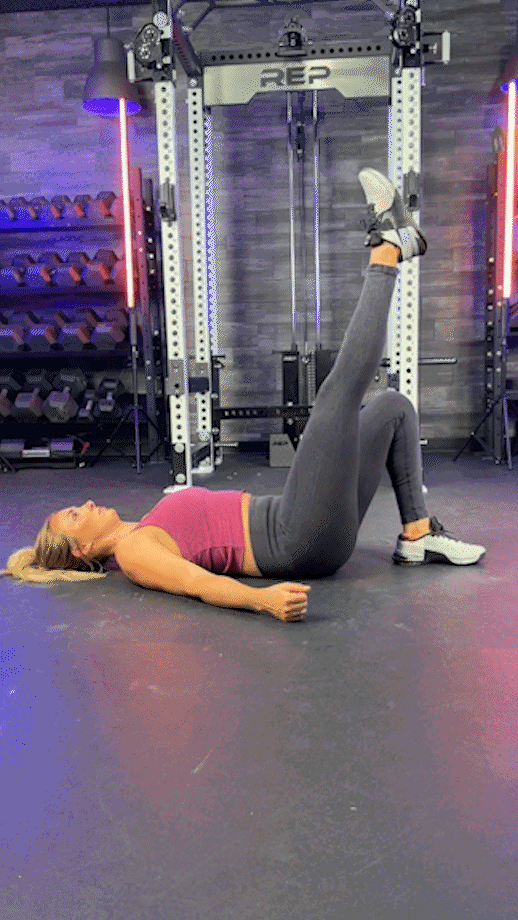
Standing Banded Adduction
Why it’s great: It’s a more advanced version of the seated banded adduction above. You can easily step away from the anchor point to increase your level of resistance and help improve your balance because you’re standing throughout.
How to do it:
- Loop a resistance band around a power rack, door, or another heavy object.
- Stand up tall, then loop the other end of the resistance band around your left ankle.
- Step away from the anchor point, then bring your left leg slightly off the ground and position it so it’s on the left side of your body. Ensure that your left leg is straight.
- Now, move your left leg across your body toward your right leg, contracting your adductor muscle as you do so.
- Pause, then return your left leg to the side.
- Repeat for repetitions, then change over to the right side.
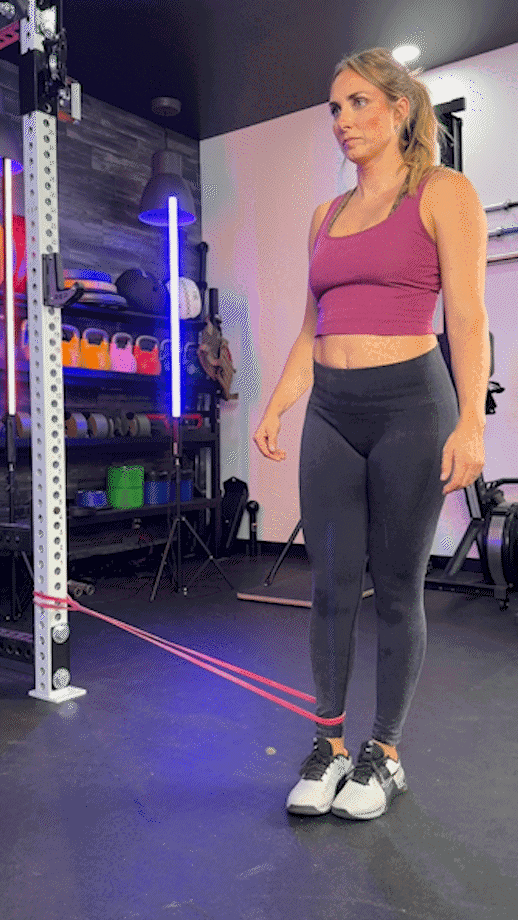
Side-Lying Adduction
Why it’s great: In terms of difficulty, side-lying hip adductions are one of the easier exercises on this list. You can do it with just your bodyweight or add an ankle weight to increase the resistance. Because it’s a unilateral exercise, it trains both sides of the body equally.
How to do it:
- Lie down on the floor or a mat on your left side, with both legs straight.
- Bend your right leg and cross it over your left leg (your right knee should be facing the ceiling and your right foot flat on the floor).
- Place your left hand underneath your head, and your right hand on the floor in front of you.
- Raise your left leg toward the ceiling while keeping it straight at all times.
- Pause for a few seconds, then bring the left leg back down in a controlled manner.
- Continue for the desired number of repetitions, then repeat on your right side.
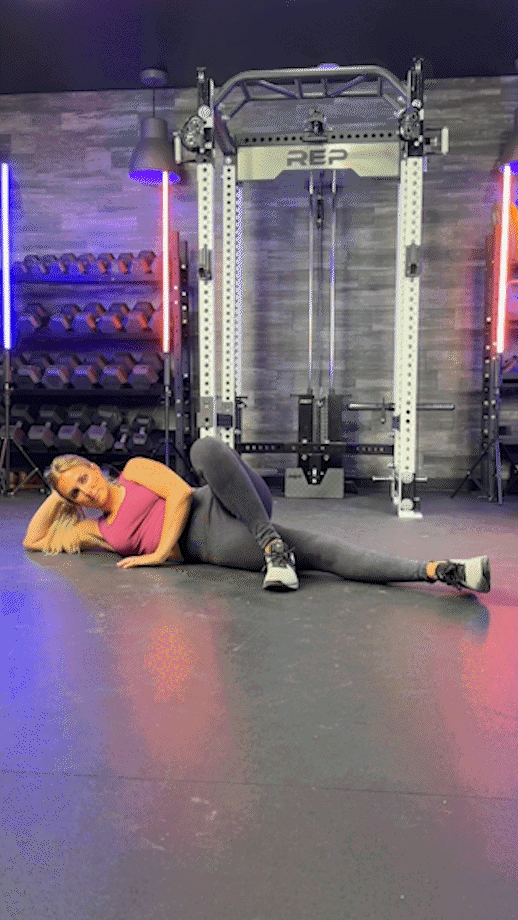
Copenhagen Hip Adduction
Why it’s great: The Copenhagen hip adduction is an advanced exercise that isolates your adductor muscles and core. You can do it at home without any additional equipment, and not only this but regularly doing this exercise can increase hip adduction strength while limiting muscle soreness5.
How to do it:
- Place a flat bench or chair near where you are.
- Get into a side plank position, with your right elbow on the floor. Put your left leg on top of the bench. You can keep the left knee bent to 90 degrees and have the entire shin bone on the bench to start, then progress to a straighter leg position with less of your leg on the bench to make this exercise more difficult.
- In the starting position, your right leg should be straight and on the floor, underneath the bench.
- To begin the exercise, engage the adductors and core, and bring your right leg (bottom leg) up until it touches the bottom of the bench, close to the top leg. Hold for a moment.
- Slowly lower your right leg back down.
- Repeat for repetitions, then switch to the other side.
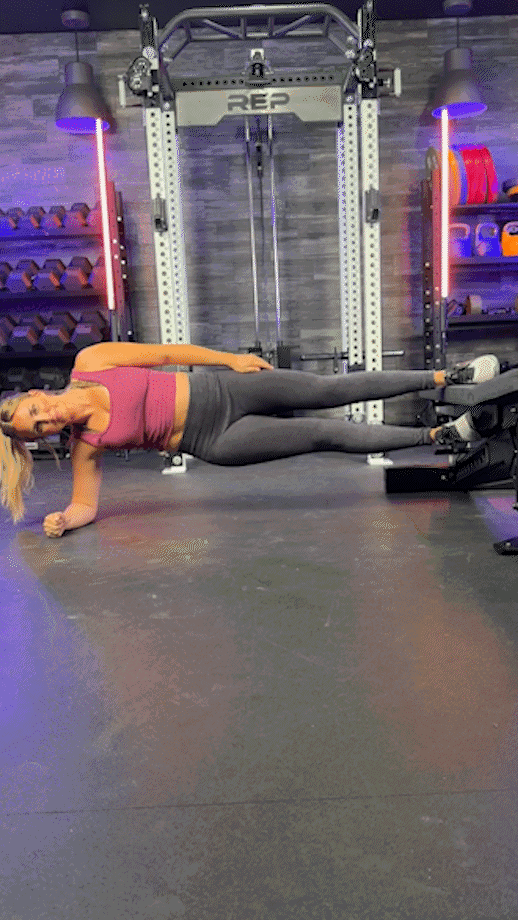
Cossack Squat
Why it’s great: You’ll stretch and strengthen the adductor muscles when doing cossack squats, helping to improve hip mobility and reduce the risk of injuries.
“Your feet are in contact with the ground at all times during this movement,” Dr. Masi says. “This makes it an ideal exercise for the joints because there’s no impact on the ankle or knee joints when you compare it with exercises such as walking lunges.”
How to do it:
- The starting position is similar to the wide stance squat above, with your feet wider than shoulder-width apart and your toes pointing outward.
- Shift your weight to the left side and squat down by bending your left knee. Drive your hips backward, while keeping your right leg straight. The left foot should stay flat on the floor and the right foot may rotate up so the heel stays in contact with the floor.
- Keep squatting until your left quad is parallel to the floor, making sure your back is straight and your core is engaged.
- Push through your left heel to return to the original position, then squat to the right.
- Continue for reps, alternating between each side.
RELATED: Squat Anatomy
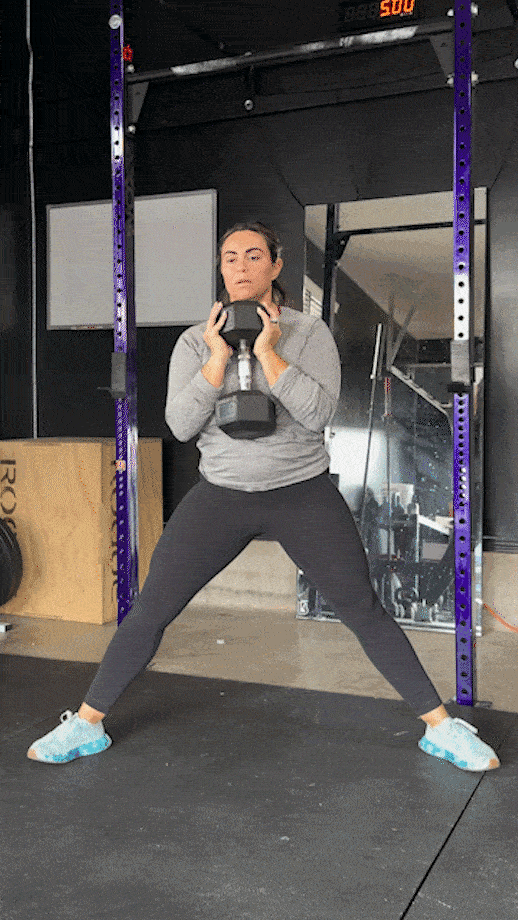
Benefits of Doing Adductor Exercises
There are tons of benefits of doing adduction exercises. Here are the three most important:
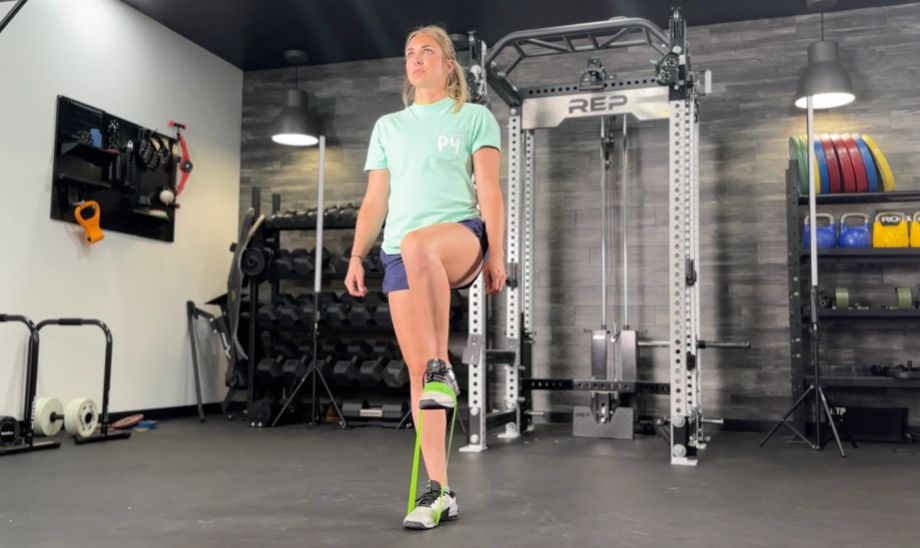
Prevents Injuries
Hip adductor strength is one of the most common risk factors for groin injuries in sports6. While exercises such as squats and deadlifts target the adductors in some way, doing targeted adductor exercises can help build strength, and the muscle you’ll build can help with injury prevention7, especially groin strains.
Helps With Compound Lifts
When you squat or deadlift, you use the adductors. This is because they’re also responsible for hip flexion and hip extension. Weak adductor muscles may be what’s stopping you from getting stronger at the compound lifts8, especially lifts for the lower body.
Increases Flexibility
“Better hip flexibility may decrease the physical demands on neighboring body regions, such as your lower back or knees, and in turn, may mitigate the risk for injury to these areas. Dr. Masi says, “Tight or weak adductor muscles may be what’s preventing you from fully extending your hips and improving your mobility, which is especially important for athletes who are looking to achieve deep squats, long lunges, or high-intensity sprints.”
RELATED: Hip Flexor Exercises
FAQs: Adductor Exercises
What exercise works the adductors?
If you’re looking to work the adductors, try some or all of the following exercises:
– Lateral lunge
– Seated banded adduction
– Wide stance squat
– Single-leg glute bridge
– Standing banded adduction
– Side-lying adduction
– Copenhagen hip adduction
– Cossack squat
All these exercises work the adductors, but it’s worth trying a few different hip adductor exercises to see which you prefer.
What is the best exercise for adductor strengthening?
Several exercises are great for adductor strengthening, but the best one is a matter of personal preference. Beginners or those with groin pain may try bodyweight exercises such as lateral lunges, side-lying adductions, and cossack squats.
If you’ve been training for a while, try unilateral exercises such as single-leg glute bridges or Copenhagen hip adductions. Add a dumbbell, kettlebell, or resistance band for extra difficulty. Personally, cossack squats are one of my favorite exercises for adductor strengthening.
How can I train my adductors at home?
Training the adductors at home depends on whether or not you have any equipment. If you don’t, don’t worry because plenty of exercises for the adductors don’t require equipment, such as wide stance squats and lateral lunges. If you have kettlebells or dumbbells, the list is endless when it comes to training the adductors at home.
RELATED: Best Compact Exercise Equipment
Do squats work the adductor muscles?
Yes, all types of squats work the adductor muscles in some way. However, if you’re looking for more adductor muscle activation, we’d recommend using a wider squat stance than you would with a regular squat (meaning wider than shoulder-width apart). This position increases inner thigh activation and is better for the adductor muscles.
Alternatively, to target this specific muscle group, you can do a cossack squat. With this strengthening exercise, you will squat from left to right while keeping both feet planted firmly on the floor throughout the movement.
References
- Jeno SH, Schindler GS. Anatomy, Bony Pelvis and Lower Limb: Thigh Adductor Magnus Muscle. [Updated 2022 Aug 1]. In: StatPearls [Internet]. Treasure Island (FL): StatPearls Publishing; 2023 Jan-. Available from: https://www.ncbi.nlm.nih.gov/books/NBK534842/
- Adductor Magnus. (2023, May 4). Physiopedia, . Retrieved 21:19, July 17, 2023 from http:///index.php?title=Adductor_Magnus&oldid=332935.
- Calatayud J, Vinstrup J, Jakobsen MD, Sundstrup E, Brandt M, Jay K, Colado JC, Andersen LL. Importance of mind-muscle connection during progressive resistance training. Eur J Appl Physiol. 2016 Mar;116(3):527-33. doi: 10.1007/s00421-015-3305-7. Epub 2015 Dec 23. PMID: 26700744.
- Hip Abductors. (2022, January 24). Physiopedia, . Retrieved 14:35, July 18, 2023 from http:///index.php?title=Hip_Abductors&oldid=292424.
- Polglass G, Burrows A, Willett M. Impact of a modified progressive Copenhagen adduction exercise programme on hip adduction strength and postexercise muscle soreness in professional footballers. BMJ Open Sport Exerc Med. 2019 Oct 15;5(1):e000570. doi: 10.1136/bmjsem-2019-000570. PMID: 31673404; PMCID: PMC6797385.
- Whittaker JL, Small C, Maffey L, Emery CA. Risk factors for groin injury in sport: an updated systematic review. Br J Sports Med. 2015 Jun;49(12):803-9. doi: 10.1136/bjsports-2014-094287. Epub 2015 Apr 1. PMID: 25833903.
- Harøy J, Wiger EG, Bahr R, Andersen TE. Implementation of the Adductor Strengthening Programme: Players primed for adoption but reluctant to maintain – A cross-sectional study. Scand J Med Sci Sports. 2019 Aug;29(8):1092-1100. doi: 10.1111/sms.13444. Epub 2019 May 23. PMID: 31050056; PMCID: PMC6851742.
- James, E. (May 23, 2023) The Why and How of Training Your Hip Adductors. NIFS. Retrieved July 18, 2023, from https://www.nifs.org/blog/the-why-and-how-of-training-your-hip-adductors
Further reading

I love a good showdown between two pieces of the best home gym equipment. It makes me feel like I'm John Cena or in the WWE. A man can dream, ok? Anyway, I’m sharing with you, the lovely readers of Garage Gym Reviews, my thoughts on two of the best adjustable dumbbells in the game: the Ironmaster Quick-Lock Adjustable Dumbbells and the PowerBlock USA Elite Series Adjustable Dumbbells.In this showdown, you’ll hear my thoughts on the great Ironmaster vs. PowerBlock debate and what I think you really need to know. Neither of these products are exactly monetarily equivalent to picking up a sausage biscuit at McDonald’s, so I know you want to get this purchase right. I’ll help by giving you all the details on price, warranty, customer reviews, and workout experience. Read more

Why should you do the double kettlebell swing? And how do you do it? A personal trainer weighs in. Read more

For this BPN Endopump review, we tested the pre-workout to find out if a stim-free supplement can really deliver the blood flow and muscle pumps it promises. Read more

The best BCAA for women can help support strength training efforts, as well as muscle gain and recovery. Here are our top picks, approved by a sports dietitian. Read more

